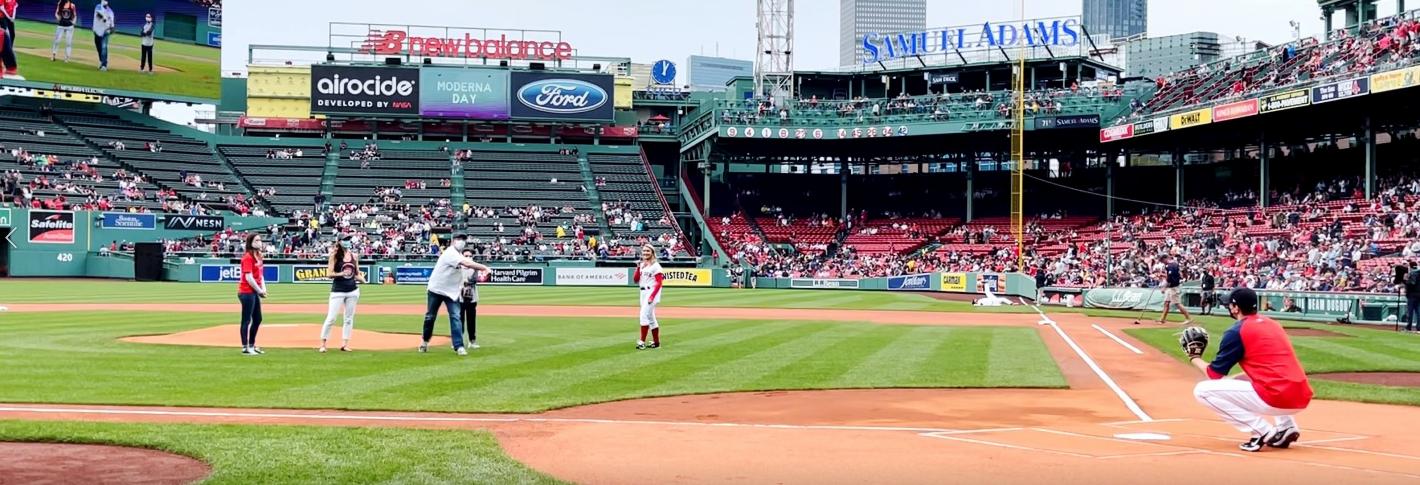
In the Picower Institute, postdoc Izabella Pena performs neurobiology research but what brought her to the pitcher’s mound of Fenway Park to help throw the ceremonial first pitch Sept. 5 was, in a sense, her role as a research subject. Her participation in Moderna’s Covid-19 mRNA vaccine trial and her engaging, first-hand advocacy to promote vaccination and fight misinformation in LatinX/Hispanic communities, earned her a featured spot on the field representing science communicators and volunteers on “Make it Yours with Moderna” day at Boston’s legendary ballpark.
Almost as soon as the pandemic reached her native country of Brazil, Pena understood that as a scientist she had a voice that could help people stay safe.
“It all started when I recorded short WhatsApp audio messages to explain about the SARS-Cov-2 virus to my family and friends in Brazil,” Pena said. Her messages spread far and wide from there. “There was a need for communication of what was going on with Covid-19 using scientifically accurate information and in lay terms. I realized how much voice scientists like me can have on social media and then I moved into creating a YouTube channel in Portuguese and focused on sharing informative threads on Twitter to explain and promote vaccines.”
In addition to her outreach on social media, Pena also joined with like-minded students and scientists at Harvard to disseminate reliable Covid information and translate it into Portuguese and Spanish in the website contracovid.com.
Above: Brigham and Women's Hospital physician Lindsey Baden throws out the ceremonial first pitch with Picower postdoc Izabella Pena to his immediate right and Moderna Scientist Hamilton Bennett further to the right. Image courtesy of Pena.
In August 2020, she found a way to help even more. By signing up to volunteer for the Phase III clinical trial of Moderna’s vaccine (the Cove study), Pena not only contributed to science as a subject, but also gained a platform to speak first-hand to her growing audience about mRNA vaccines, how they work, and what her experience was in the trial.
“The opportunity to participate in the Cove study was unique for me to be able to communicate the nuances of the vaccine trials from within,” Pena said. “I tried my best to communicate that I was never scared of the vaccine, despite what is said about it being ‘new’ or ‘rushed,’ among other fake news. I communicated about how carefully the trial was performed and that mRNA vaccines were not developed ‘overnight’ but after 30 years of history.”
Ultimately through her trial participation and communications work, Pena got to know scientists at the Brigham and Women’s Hospital where the Boston arm of the trial was conducted, including Lindsey Baden who led the Cove study and Moderna’s scientist Hamilton Bennett, who led the vaccine development. Baden invited her to join him and Bennett at Fenway where the Red Sox were set to play the Cleveland Indians (soon to be the Guardians).
“Lindsey invited me to share this moment of celebration to represent the thousands of volunteers and science communicators that were also essential to make the trials and the actual vaccinations a success,” she said. “I feel very humbled to share this moment with Drs. Baden and Bennett and feel very proud of being part of the study.”
The pitch was televised. Pena said she hopes that putting the vaccine in the spotlight will convince more people in states such as Ohio, which has below-average vaccine adoption, to get life-saving vaccine shots.
Helping people through research
Pena’s efforts to help communities better understand how to stay safe from Covid-19 is not the only way she is working to save lives. Her research in the Picower Institute lab of Latham Family Associate Professor Myriam Heiman is focused on improving understanding of Huntington’s disease (HD), an incurable and terminal genetic disorder.
Pena began working on the research while at the Whitehead Institute and recently began to collaborate with Heiman who is a leading expert on molecular mechanisms underlying HD pathology. Recently, Pena moved to Heiman’s lab full-time.
In the course of the disease, brain cells die amid runaway aggregation of mutant huntingtin protein. Scientists don’t know exactly why the neurons die, but increasingly they have focused on two components within cells: the lysosomes and the mitochondria. In her research, Pena is working with mouse models to compare and analyze the molecular composition of those components in healthy neurons and ones with the HD mutation to see how they differ.
“We may discover novel biomolecules—small chemical compounds, proteins and RNA—implicated in HD that may help us understand what is wrong in the affected neurons,” she said.
Those molecules could be biomarkers that help indicate disease progression and could offer clues about new interventions that could help.
As a researcher, a research subject and a public advocate, Pena is working to save lives through science.






